Adrian Collins's Blog, page 12
August 3, 2025
REVIEW: Empire of Silence by Christopher Ruocchio
A melodramatic, poetic, and deeply interesting framed narrative, Christopher Ruocchio’s Empire of Silence is an exciting debut that may have finally made me fall in love with sci-fi as a genre. Hadrian Marlowe, a man of great heroism and greater atrocity, tells his story and how he became a figure known across the galaxies.
“Atrocity is writ by quiet men in council chambers over crystal glasses of cool water. Strange little men with ashes in their hearts. Sans passion, sans hope… sans everything. Everything but fear.”
Before getting into this review, I have to say, Ruocchio can fucking write. Sci-fi, despite my love for fantasy, has generally never really done it for me. There’s been a few entries into fantasy’s sister genre that I’ve fallen in love with (Hyperion, Book of the New Sun) but generally speaking, I’m all in when it’s swords & horses and all out when it’s lasers & spaceships.
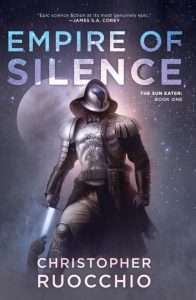 Empire of Silence may have changed that for me.
Empire of Silence may have changed that for me.
The narrator of Empire of Silence, Hadrian Marlowe, is superbly written. This is a framed narrative a la Name of the Wind or Blood Song, and while we don’t have any interludes set in the “present”, Hadrian does have some winks, foreshadowing, and fourth wall breaks as he acknowledges the way this story is being told.
While Hadrian is a man who has set the sky aflame and snuffed out billions of souls, Empire of Silence shows us his beginning. He’s a lord who never quite fits in with his privileged peers and family. His teachers lovingly berate him for being melodramatic, his father and brother hate him because they don’t understand him. Regardless of who he’s with, Hadrian is unable to stop his heart from bleeding, and it creates a nuanced main character who has to weigh his position against his instincts.
I absolutely adore both Hadrian and ultimately, Ruocchio’s writing. Empire of Silence burns white-hot sometimes, showing the burning potential that Sun Eater has. My favorite chapter in this tale is just a bit over a page in length, but every word of it set my mind alight and stirred my soul.
The world-building is as strong as the writing. We see only a few planets, but you can truly feel the scope of the setting that Ruocchio has built. The people who populate the planets are unique from each other, but also, still human. They all crave bloodsport, all crave a better life. Behind the scenes of Empire of Silence we do get some extremely cool foreshadowing about an elder race, as well as humanity’s designated eternal enemy: the Cielcin. A breed of ghostly white, elongated humanoids that the church has marked as demons and the armies fight across the galaxy.
“The world’s soft the way the ocean is. Ask any sailor what I mean. But even when it is at its most violent, Hadrian . . . focus on the beauty of it. The ugliness of the world will come at you from all sides. There’s no avoiding it. All the schooling in the universe won’t stop that.”
While I love the writing, the main character, and the world-building in Empire of Silence, I did have a few problems. The pacing in it is weird to describe: it’s a slow book with short, snappy chapters. It dwells on places for a bit too long sometimes, especially the first twenty-five percent, which is a bit of a rocky start. The dialogue in Empire of Silence is mostly good, but only really shines in a few moments between Hadrian and Valka. Some of the side characters are one-note, instead of feeling like fully fleshed out, real people. Finally, I’ve always disliked sci-fi’s hand waving of “we have shields that stop bullets but not swords.” That’s strictly a personal, petty nitpick, but it’s one I need to call out.
I’ll be honest, I actually picked up Empire of Silence a long time ago and ended up DNFing it. I am so glad I came back, especially given the last two hundred pages or so of the book. The problems I highlighted are not only minor—and only worth highlighting when you compare them to the highs that Ruocchio offers—they all feel like classic debut snags, and as Ruocchio grew more confident, his skills increased. Based on everything I’ve heard, I’m expecting the remaining books to blow me away, and regardless, Empire of Silence is a great book.
If you’re looking for sci-fi’s version of The Name of the Wind—or just a great book in general—pick up Empire of Silence. It’s one of the more exciting debuts I’ve read and Ruocchio has the potential and skill to write an all time classic series.
Read Empire of Silence by Christopher RuocchioThe post REVIEW: Empire of Silence by Christopher Ruocchio appeared first on Grimdark Magazine.
August 2, 2025
INTERVIEW: author Essa Hansen
Essa Hansen grew up in the beautiful wildernesses of California, from the coastal foothills to the Sierra Nevada mountains, and then the Canadian Rocky Mountains, before settling back at the California coast. She has ranched bison and sheep, trained horses, practiced Japanese swordsmanship, and is a licensed falconer. By day she works as Nia Hansen for Skywalker Sound as a sound designer on science fiction and fantasy films for clients such as Marvel, Pixar, and Disney Animation. We were very excited to be able to catch up with her and chat about her new novella Casthen Gain, the world of The Graven, and what she’s getting up to next.
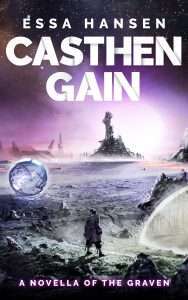 [GdM] Hi Essa, thanks for chatting. Your new novella Casthen Gain, a prequel to your sci-fi trilogy The Graven, comes out on 28 July from Grimdark Magazine, the very people interviewing you now, in a pleasingly circular development. Can you give us a quick rundown of what it’s about and whether readers unfamiliar with the unfathomable genius of The Graven can still pick this up?
[GdM] Hi Essa, thanks for chatting. Your new novella Casthen Gain, a prequel to your sci-fi trilogy The Graven, comes out on 28 July from Grimdark Magazine, the very people interviewing you now, in a pleasingly circular development. Can you give us a quick rundown of what it’s about and whether readers unfamiliar with the unfathomable genius of The Graven can still pick this up?
[EH] Thank you for inviting me to chat! It’s been great fun revisiting the bubble multiverse of The Graven trilogy. Although Casthen Gain contains cameos and hidden gems for readers of the trilogy, grasping them isn’t necessary to enjoy this standalone story.
Casthen Gain straddles the line between science fiction and fantasy as it follows Sentace Ketch, a multiversal chef thrown into a battle royale hunt for a mysterious energy on an overgrown and dangerous planet in the vein of Scavengers Reign. The arsonist revolutionary he’s been chasing could be his salvation or a death wish, and complicates the game in ways he wasn’t expecting. Add an adorable fluffy alien companion and a squid-thing in a skull jar and you’ve got a weird little found family that I hope readers fall in love with as much as they did the trilogy’s found families.
[GdM] What made you want to jump back into the world of The Graven, and why this prequel story in particular? Was there a particular reason you wanted to explore everyone’s favourite morally grey, ruthless, mulitverse organisation The Casthen?
[EH] For a long time I’ve been wanting to write a story about a chef character traveling through dangerous lands, and also wanting to answer some of the questions that The Graven didn’t get around to. Over time, those two concepts merged. In the bubble multiverse, physical laws are different within each “bubble” area of space, meaning materials change in various ways as they pass through bubble borders: the perfect situation for imaginative cuisine, literally transforming ingredients and cooking them using physics translations.
The Casthen organization has been around for ages, so it was a logical anchor point for a prequel story. (I wanted to cameo everyone’s favourite morally grey, ruthless badboy Threi during his younger decades with the Casthen, but the timeline proved too finicky.) I intended this novella to highlight some of the same themes as The Graven, ones that naturally crop up around the Casthen organization: questions of autonomy, moral dilemmas from different perspectives, win/lose choices around morality and ethics, corrupt systems and the capacity for goodness to exist despite them, and whether one can use the enemy’s resources for a cause that’s just. Besides all that, the Casthen is where the discards of the world end up (and are exploited), and Sentace is just that.
[GdM] Battle royale is a very particular genre with a set of well-known grim tropes. What made you want to give it a go—and were you influenced by any previous battle royale stories?
[EH] A novella length story wasn’t going to give me time to properly lay out a battle royale plot with the complexity or ensemble cast of stories like the 2000 cult classic Battle Royale, or Alice in Borderland, or the more recent Squid Games. At least, not unless I made the battle royale the entire story. In Casthen Gain, it’s more of a backdrop—one that perfectly fits the Casthen’s way of operating. It hits the right themes for this story: survival through dangerous environments alongside an exploration of grey morality and relationship dynamics under high tension. My favourite part of the genre is the inherent unpredictability of individuals pushed to the brink of stress and exhaustion. A wild creativity becomes possible, with characters surprising themselves and the audience with their choices. In Casthen Gain, I started with a protagonist at a pivot point in his life where he’s ready to become someone new but isn’t quite sure who that is…and the stressors of this survival genre were the perfect place to put his becoming to the test.
[GdM] You’ve done something very interesting with this story, which is that you’ve kept a lot of the grimdark brutality of battle royale but added in what you could call a few cosy elements, including extended scenes of bubble universe cooking [which will make glorious sense when you read it, reader]. I call this cozy grimdark… where did the cooking element come from?
[EH] I seem to fall into this rhythm with every story I write: periods of high tension, stakes, action, and hurt, followed by the quiet, slow, intimate moments of comfort and healing. Then back again, in juxtapositions of brutal and beautiful. I enjoy reading this rhythm as well.
Across cultures, cooking is one of the quintessential ways to show care, to nourish, to bring together, to repair. In The Graven, I wrote a character—Ksiñe, the gastronomist and medic of the crew—who communicates primarily through food, and here too I wanted to explore food as a language, a syntax of peace-offering, of care, strengthening, and acknowledgment. Alongside that, battle royale is a survival genre, and survival requires nourishment. You can’t expect to be efficient in combat or mental clarity or navigating long distances if your whole system isn’t fuelled. I wanted to write a protagonist who understands this. I feel like I rarely see it highlighted in the SF/fantasy genre.
[GdM] This is a very food-based story, so inevitably I’m going to now ask you to provide your favourite/dream three-course meal.
[EH] This may sound like I’m evading the question, but I’m more of a mood-based consumer (with media too!) than one with firm favourites, so genuinely I think the dream meal for me would be to leave it up to the chef to surprise me, but this chef can perceive or intuit exactly what I need in that moment. This is how Sentace cooks for his clientele, different species and cultures from all across the multiverse.
 Author Essa Hansen
Author Essa Hansen[GdM] It’s been a couple of years since The Graven trilogy concluded. Fans of The Graven tend to eulogise it and call it one of the best modern-day sci-fi series. Looking back, how do you feel about that series, good and bad, in terms of how you think of it, how others think of it, and how it’s affected your life?
[EH] It’s strange looking back on work that’s three…five…seven years old. I’ve grown immensely through those books and since them, so reading old work can be quite cringe! Mostly I remember being extremely rushed at every stage of the trilogy, like setting track out in front of a speeding train, writing during the leftover hours of the day around a full time job and life’s stressors. The first book debuted in 2020 when the beginning of the pandemic shut the industry down, bookstores were closed, books were abandoned by their teams, and many people—myself included—were locked down alone for months, completely burnt out.
Despite the rough start and middle and end of the process, I’m very proud of my effort, of finishing, and of surviving it in every sense of that word. I stand by the ideas of the series and what I was attempting to convey, and my fans who really “got” the story are one of the best things about the whole experience for me. They kept me going during the days when it felt impossible to finish.
[GdM] Moving on to your life outside writing, you have what I think it’s fair to say is a pretty cool-sounding job: sound designer for Skywalker Sound for clients such as Marvel, Pixar, and Disney Animation. You’ve worked on Ant Man, Jurassic World, Big Hero 6, Avengers Endgame, the list goes on. Can you give us a sense of what that job entails?
[EH] It is pretty cool! Especially since I get to work in my favourite genres. As a sound designer, I guide the sonic aesthetic of the film by managing the sound effects team and coordinating with the filmmakers, but mostly I’m creating bespoke sounds from scratch: all of the emotional, surreal, or fantastical sounds we cannot record in real life, such as strange creatures, superpowers, spaceships, aliens, magic, and dreamy sequences. I take an organic approach, which involves manipulating and layering recordings of real materials to make something that feels realistic but also sounds otherworldly, exotic, or high tech.
I also do a lot of sound effects editing, which is like painting but with sound, and has a temporal aspect like music. I love the combination.
[GdM] What’s the most challenging sound you’ve had to recreate, or edit? Very much hoping that’s not the most stupid question you’ve ever been asked, but time will tell.
[EH] It’s not at all a stupid question—I get asked this in pretty much every audio interview! Currently the most challenging sound I’ve had to design is the “time shard spears” from Marvel’s Doctor Strange, which are swords made from rips in spacetime itself. The challenge was threefold. For one, I had no visuals or other descriptors besides the name when I started designing, so I was creating off of pure imagination. Two, once we received visual shots, the visual effects ideas continued to evolve, so what might seem like glass at first would become liquid or air, then vibration, perhaps back again. Visual effects intensive films are always a challenge for this reason. Thirdly, it can be very difficult find the right language to discuss sound concepts creatively (for example, “warpy” might conjure a different sonic idea to different people), and that’s exacerbated when the object or event itself is also difficult to describe, as happens often in these genres (like spacetime tearing).
[GdM] You’re also an accomplished swordswoman, rancher, horse trainer, and falconer, to name but a few. How do you choose these random cool things to learn – do you have a grand polymath plan, or do you just wander into them? I’m asking as someone who’s only good at video games.
[EH] I wander into my hobbies, but since I love animals, the outdoors, and crafts, that tends to prescribe me all the fantasy genre hobbies. I would do even more things if I had the time—get back into archery at least—but my free hours have shrunken over the years. Also yes to video games…I’m behind on so many!
[GdM] As someone for whom writing is not the only creative thing in their life, how much importance do you ascribe to it—do you hope to have a lifelong career in it, or would you be fine with it falling away? And do the stresses and problems with modern-day publishing and the increasing difficulties for authors to make careers in it ever influence your thinking in this regard?
[EH] I would love to have a lifelong career as a writer—or at the very least add something meaningful and unique to my genres. I’ve been writing stories and worldbuilding for as long as I can remember, and will continue to do so for the pure joy of the creative process. As you mentioned, the current issues with publishing take out of my hands much of my career, my titles’ visibility and performance, and how I’m treated as an author. Most days it feels like all I can do is continue to write stories that I love and that hold meaning, and hope they’ll find an audience who loves them too.
[GdM] Finally, what can you tell us about your future writing plans? Any new plans to dive back into The Graven? Or any new series in the wings?
[EH] The Graven is done for now! Or at least there is nothing more on the horizon.
I’m currently working on a standalone cross-genre novel that blends the expansive weirdness of Inception, the tranquil horror of Annihilation, and Iain M. Banks’s inclusive world of The Culture. The story leans into my brand of unique and beautiful spectral worlds filled with broken characters who have to break themselves more in order to repair themselves and their world. I hope it finds a home and heads into readers’ hands one day.
Read Casthen Gain by Essa HansenThe post INTERVIEW: author Essa Hansen appeared first on Grimdark Magazine.
August 1, 2025
REVIEW: Squid Game Season 3
The third and final season of Squid Game has arrived and the international hit sensation about contestants fighting for survival in a series of deadly games for life changing money finishes on a high. The Korean continues Seong Gui-hun’s attempt at taking the games down from the inside and wraps up the core story whilst leaving ample space for what now looks like the start of a Squid Game universe.
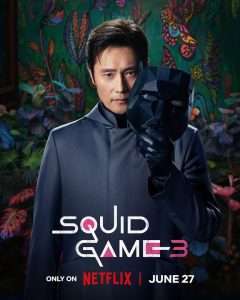 Squid Game S3 is a step up from the slower paced second season. We spend more time on the island where players are trapped and competing in the deadly games and the brutality ramps up in a series that has never shied away from darkness. Whilst Squid Game S3 doesn’t have the freshness of that first season, it is a step up from the plodding second season. Gi-hun is still reeling from his failed rebellion and betrayal by a man he thought was on his side. The Front Man, played brilliantly by Lee Byung-hun (A Bittersweet Life, I Saw the Devil, Terminator: Genysis) is one of the best characters of the season. Looking after the games whilst his brother frantically searches for him, he displays moments of heart that go against his role as the face (or mask?) of the brutal games. He is one of the characters that shows true development and it has been interesting to watch his progression throughout the series. There are emotional moments as characters show some compassion within the games but do not always get the reward they deserve as the deadly nature of the games take over and the greed and corruption in such an environment threaten to take over. Squid Game has always been about what can happen when people truly have their backs against the wall, contestants and guards alike, and it is the choices that are made whilst survival is almost within the grasp of some that make Squid Game S3 standout. The kills are as brutal as they ever have been and there is a sense of loss in this season that permeates as we follow Gi-hun at his lowest. He could have left for America to be with his daughter but instead he starts the season chained up in a room and struggling to find a will to fight any more. Of course, he is given a reason to live and his fight is compelling as he faces incredible odds once more as he tries to save as many people as he can.
Squid Game S3 is a step up from the slower paced second season. We spend more time on the island where players are trapped and competing in the deadly games and the brutality ramps up in a series that has never shied away from darkness. Whilst Squid Game S3 doesn’t have the freshness of that first season, it is a step up from the plodding second season. Gi-hun is still reeling from his failed rebellion and betrayal by a man he thought was on his side. The Front Man, played brilliantly by Lee Byung-hun (A Bittersweet Life, I Saw the Devil, Terminator: Genysis) is one of the best characters of the season. Looking after the games whilst his brother frantically searches for him, he displays moments of heart that go against his role as the face (or mask?) of the brutal games. He is one of the characters that shows true development and it has been interesting to watch his progression throughout the series. There are emotional moments as characters show some compassion within the games but do not always get the reward they deserve as the deadly nature of the games take over and the greed and corruption in such an environment threaten to take over. Squid Game has always been about what can happen when people truly have their backs against the wall, contestants and guards alike, and it is the choices that are made whilst survival is almost within the grasp of some that make Squid Game S3 standout. The kills are as brutal as they ever have been and there is a sense of loss in this season that permeates as we follow Gi-hun at his lowest. He could have left for America to be with his daughter but instead he starts the season chained up in a room and struggling to find a will to fight any more. Of course, he is given a reason to live and his fight is compelling as he faces incredible odds once more as he tries to save as many people as he can.
There are other story arcs within Squid Game S3 but none really have the depth of Gi-hun’s. There is a final tease of where the show is heading in the future and with Squid Game 87 and Squid Game USA already announced, this isn’t the end of the hit show. Look for more brutality, more downtrodden folk, more greedy capitalist westerners, and Cate Blanchett – I can’t wait!
Whilst it doesn’t hit the heights of the first season, Squid Game S3 is a great send off to what has been a remarkable series. The South Korean show stands alongside stories such as Battle Royale and Hunger Games and adds its own spin to make it stand out against such efforts. Seong Gi-hun is one of the best characters seen on TV this decade and whilst I am glad to see his story wrapped up with a grimdark bow, I am excited for what else is to come.
The post REVIEW: Squid Game Season 3 appeared first on Grimdark Magazine.
July 31, 2025
REVIEW: Crypt of the Moon Spider by Nathan Ballingrud
For those who can remember introductory English classes, Crypt of the Moon Spider is like if Charlotte Gilman’s The Yellow Wallpaper took place on the moon—with psychic spiders, spider-silk lobotomies and a repressed woman’s eight-legged revenge. In this first novella of what will be The Lunar Gothic Trilogy, Nathan Ballingrud has gifted us with a story that goes from eerie to downright nightmarish, with a feverish ending that I happily savored long after turning the last page (arachnophobes, stay away).
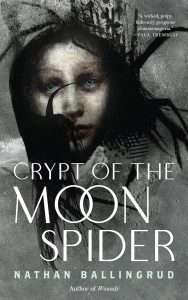 It’s 1923, and Crypt of the Moon Spider opens with Veronica being dropped off (read: abandoned) by her husband at the Barrowfield Home for Treatment of the Melancholy, a mental institution on the forested dark side of the moon. It’s run by Dr. Barrington Cull—who can quickly be pegged as the mad scientist sort—and his brutish assistant who Veronica calls Grub. The doctor is renowned for lobotomizing patients and using the silk of the long dead moon spiders to repair their brains. He is aided in surgeries by the white-clad acolytes of the moon spiders, the Alabaster Scholars. Once the surgeries start, Veronica begins to lose grip on reality. She drifts into unsettling flashbacks to her childhood that suggest either Cull or the Scholars are implanting memories, or she’s repressed her dark past. Grub, whose masterfully written and chilling dialog I loved, is revealed to have a surprising role here, too.
It’s 1923, and Crypt of the Moon Spider opens with Veronica being dropped off (read: abandoned) by her husband at the Barrowfield Home for Treatment of the Melancholy, a mental institution on the forested dark side of the moon. It’s run by Dr. Barrington Cull—who can quickly be pegged as the mad scientist sort—and his brutish assistant who Veronica calls Grub. The doctor is renowned for lobotomizing patients and using the silk of the long dead moon spiders to repair their brains. He is aided in surgeries by the white-clad acolytes of the moon spiders, the Alabaster Scholars. Once the surgeries start, Veronica begins to lose grip on reality. She drifts into unsettling flashbacks to her childhood that suggest either Cull or the Scholars are implanting memories, or she’s repressed her dark past. Grub, whose masterfully written and chilling dialog I loved, is revealed to have a surprising role here, too.
After this slow burn beginning, the plot frantically gallops towards a mind-bending finale. Cleaved skulls, giant spider legs erupting out of brains, and Bene Gesserit style schemes wrap up what is now one of my favorite novellas.
Setting the book in 1923 allows Barrowfield to mirror the horrific and inhumane treatment of people—and especially women—who suffered from mental health in this era (and still today, though less extreme). At times, I was enraged. At others, heartbroken. As someone who knows the feeling of being institutionalized, I think several passages poignantly communicated that experience. The scene where the door closes to her cell, and she’s sitting alone on her bed, in silence, was deeply moving. There’s a palpable claustrophobia to the whole book, as well. Veronica is confined in her mind, and her life has been confined to the whims of men. This makes her later empowerment, though gruesome, rather satisfying.
While I was fully onboard with an interesting sci-fi/horror plot, Ballingrud’s elegant, evocative and at times truly arresting writing style was my favorite aspect. Veronica is often lost in detached fantasies to escape her depression, and the book perfectly captures that state with haunting analogies and descriptions of the world around her. The effect of his prose was striking enough that I wanted to reread so many sentences, but the writing was so smooth that I found myself gliding through page after page.
Crypt of the Moon Spider ends up being more of an emotional and sensory experience rather than a cerebral one. The book brings up important ideas of women’s agency and mental health, which definitely helps electrify the end of Veronica’s character arc. However, they seem more like tools to achieve certain emotional payoff moments rather than points of conversation. Not necessarily a shortcoming, but a trade off, especially to maintain the wonderful pacing of this short work.
I ended up reading Crypt of the Moon Spider twice, and loved lingering in its beautiful, haunting dreamscape just as much both times. Whether you come for the spiders or the prose, I think you’ll leave happily unsettled by both.
Read Crypt of the Moon Spider by Nathan BallingrudThe post REVIEW: Crypt of the Moon Spider by Nathan Ballingrud appeared first on Grimdark Magazine.
July 30, 2025
REVIEW: The Bonehunters by Steven Erikson
Steven Erikson’s The Bonehunters is a bloody, ash-covered success that fulfills the promise of war whispered by House of Chains. While the philosophy, sarcasm, and mystery that Erikson is known are found in spades in The Bonehunters, readers should prepare for fire, chaos, claustrophobia, and one of the greatest convergences in Malazan.
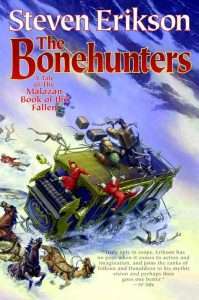 “Show me a god that does not demand mortal suffering.
“Show me a god that does not demand mortal suffering.
Show me a god that celebrates diversity, a celebration that embraces even non-believers, and is not threatened by them.
Show me a god that understands the meaning of peace. In life, not in death.”
The Bonehunters is where we really start to see how everything comes together. For those who haven’t read Malazan that sounds almost impossible: we’re on book six and over a million words in. Erikson, however, has been keeping his secrets close to the chest and doling out information slowly, and now, finally, we begin to see the pieces clicking into place.
The plot of The Bonehunters is nothing short of outstanding. It has war, betrayal, tragedy, and the most frantic fight outside of Abercrombie’s The Heroes. This is arguably Erikson’s fastest pace novel to date, and even though the book is 350,000 words and there’s a chapter that’s 120 pages long, it never, ever feels slow. We alternate between balls-to-the-walls kickassery and normal pace, all the while Erikson takes us on this epic journey.
Action-wise, it’s arguably Erikson’s best. I may lean towards giving the nod to Memories of Ice, and there’s pockets of greatness in the other novels, but The Bonehunters evokes an epic feeling of danger that I’m just not sure I’ve seen anywhere else. I said this already, but there’s a 120 page chapter in this book and damn it, it flies by. It’s gritty and gruesome and horrible, but it’s so perfectly written that you feel like you’re there, breathing in smoke and slicing your way through the city.
It’s not just swords and flames that impress in The Bonehunters. There’s magic on display that’s wielded as cleverly and beautifully as ever; there’s undead, confused and desperate; there’s gods trying to reap their own benefits. However, we never lose the human element in these stories, even as they’re often made to feel like ants in a whirlwind.
Speaking of the human element, the banter and resigned sarcasm of the soldiers is tip-top. Hellian may be the funniest character in Malazan (although I’d still give it to Tehol) but the other soldiers never lose their edge. At this point, you should be familiar enough to know Erikson’s humor to know if it’s for you. The Bonehunters is at times more “in your face,” but it’s still the same style that we’ve grown used to.
Beneath the banter, though, some of the soldiers hint at mystery, and it’s arguably Erikson’s most enticing yet. One squad in particular meets in the shadows, never fully nefariously, but never innocently either. It doesn’t even feel morally grey or detrimental to the army’s goals, which makes it all the more enticing.
“Discipline is as much facing the enemy within as the enemy before you; for without critical judgment, the weapon you wield delivers- and let us not be coy here- naught but murder.
And its first victim is the moral probity of your cause.”
There’s essentially two climaxes in The Bonehunters. Both feature a convergence that was hinted at for a long time, but they’re also utterly unique from each other. One is fire, one is shadow. As always, Erikson brings these convergences to mind-bending greatness, but they’re so different that you really have to appreciate how he does it.
I only have one nitpick with this novel, and unfortunately it comes right at the end. Going into the details of it would put us strictly in spoiler territory, but all I can say is that one group that was promised to be a dire threat fell flat. This single scene felt almost cartoonish to me, and it is one of the main things I remember about The Bonehunters due to where it’s placed.
Regardless, this book is another masterpiece from Erikson. The Bonehunters is frequently listed as a favorite by the fans and it’s for good reason. If you’re reading this review because you found Midnight Tides too slow or philosophical, The Bonehunters will re-ignite your love for this series; if you happened to read this review because you’re considering the series as a whole, then go forth and trust in Erikson.
Read The Bonehunters by Steven EriksonThe post REVIEW: The Bonehunters by Steven Erikson appeared first on Grimdark Magazine.
July 29, 2025
REVIEW: Predator: Killer of Killers
If you’ve watched a few of the Predator movies, you may have wondered, as I did recently when The Predator (2018) came on TV, why, given the size of Earth and all the people on it, do the predators only ever seem to land in the Americas? Predator: Killer of Killers goes some way to giving us a taste of how other peoples face off against the formidable sport-hunter alien in an animated anthology format.
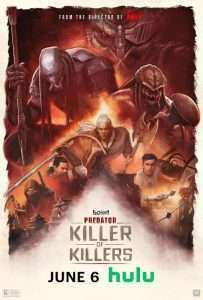 Featuring three stories from across history, Predator: Killer of Killers introduces us to Ursa, Kenji and Torres who each manage to defeat a predator as it hunts among them. Ursa is a Viking shieldmaiden, leading a raiding party of warriors as she seeks revenge for the death of her father. Kenji has fashioned himself as an assassin in early Edo-era Japan and is seeking to prove a point to the brother who betrayed him long ago. Torres is an American pilot in World War II, trying to prove himself while also being pretty handy with a wrench.
Featuring three stories from across history, Predator: Killer of Killers introduces us to Ursa, Kenji and Torres who each manage to defeat a predator as it hunts among them. Ursa is a Viking shieldmaiden, leading a raiding party of warriors as she seeks revenge for the death of her father. Kenji has fashioned himself as an assassin in early Edo-era Japan and is seeking to prove a point to the brother who betrayed him long ago. Torres is an American pilot in World War II, trying to prove himself while also being pretty handy with a wrench.
Each of these characters’ stories treats the audience to some brutal and clever fight scenes, and the beauty of being animated is it offers the opportunity to explore the weaponry of each predator they face. In live-action, this can be limited by what the props department can build but with animation there’s greater scope to let the imagination off the leash.
These characters’ differing cultures and backgrounds lend them a unique perspective on the aliens they encounter; Kenji describes them as demons, whereas Ursa calls the Predator-in-Chief ‘Grendel King’. Torres is more engineer than hand-to-hand fighter, and uses his affinity for machinery to his advantage. The variety here is a real boon to the story and action in Predator: Killer of Killers.
Each backstory shows us how these characters’ used martial prowess and battle-smarts to defeat the far superior alien species. Every one of them loses a lot in their face-off with the predator and their ultimate reward comes in the final chapter, where they find themselves forced into a battle-royale/Highlander style fight against each other to become a Killer of Killers.
The film, thankfully, doesn’t throw in any magic macguffins to allow the three to understand each other’s languages, though there was certainly an opportunity to, so they have to muddle through speaking only violence in common. They must work together, or destroy each other, to face the Predator’s leader one-on-one. You will have to watch to see who comes out victorious. Available now on Hulu or Disney+, depending on your region, Predator: Killer of Killers is a great addition to the franchise and brings some much needed diversity to the mythos.
The post REVIEW: Predator: Killer of Killers appeared first on Grimdark Magazine.
July 28, 2025
REVIEW: The Heroes by Joe Abercrombie
Facing the horrors of war with a cynical smile and a beleaguered shrug, Joe Abercrombie’s The Heroes is an action-packed, poignant, intricate tale. Abercrombie wields characters and action in a thrilling, enthralling way—the way only a master of the craft can. The Heroes will make you laugh, will make you sweat, and will make your day.
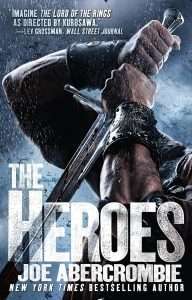 “‘Armour is a part of a state of mind in which you admit the possibility of being hit.”
“‘Armour is a part of a state of mind in which you admit the possibility of being hit.”
For me, The Heroes is the book that established Joe Abercrombie as one of the all time greats in fantasy. Each page, each POV, each desperate and frantic fight scene simply excels in this book. The Heroes is set on a worthless hill in the north over a period of just a few days, years after the main events in Last Argument of Kings and many years before A Little Hatred, and everything about it just works. It’s a premier example of lowering the stakes and raising the tension at the same time. While the size of the armies are massive, the world will continue spinning just fine regardless of who wins, but Abercrombie’s skill wraps you in and makes you care anyway.
You can’t talk about Abercrombie without talking about his character work. The world that he’s established lets each character be their own shade of grey. While there aren’t any good guys in The Heroes it’s hard to say there’s truly evil ones either. At the end of the day, even the shittiest person in this narrative feels like a real, solid person who would never consider themselves evil, only doing what is necessary. Each one brings something to the table, whether it be witty banter, philosphising, or just grit and heart, and whenever one goes back to the mud it’s a damn gutpunch.
The Heroes is arguably Abercrombie’s funniest book, and it’s generally in the style of genuine conversations and bickering that reminds me of conversations with my own friends, but there’s something more to it. There’s a realness in the levity. Bremer dan Gorst, for example, and his letters: they’re hilarious, but they also show so much of his character and how he sees the world. It is an absolute masterpiece at finding that sweet spot of humor and nuance.
Now that I’ve gushed about the characters, The Heroes greatest success is inarguably its action. This is the book that places Abercrombie as one of the best to ever do it, and there’s one chapter in particular that is absolutely breath-taking. People who have already read the novel know specifically which one, and if you pick this book up, you will too. The POV-switching, chaos, blood, and bone-crunching action is just magnificent.
The pacing, prose, and setting are all classic Abercrombie. While they do take a back-seat to the characters and the action, they’re polished to a fine shine and deserve a mention as well. The Heroes never lets go once it’s got you in its grip—and the prose and setting are more than strong enough to keep readers happy. They’re dutiful soldiers, doing their job.
“‘Heard Black Dow wants you dead.’
‘Who’d you hear that from?’
‘Black Dow.’
Traditionally, this is where I put my complaints, I have no complaints about The Heroes. There’s no such thing as a flawless book, but I’ve stared at this computer screen for a long time trying to find a hole in it to no avail. The only thing that even came to mind is that since this is a stand-alone, it’s a tad harder to feel the full weight of a character dying due to the amount of time spent with them, or lack there of.
Frankly, if you’re reading this review and haven’t read Abercrombie, you should; he’s Lord Grimdark for a reason. In fact, I’ll go a step further and say this: The Heroes is the book that heralded Abercrombie coming for the throne as the greatest living fantasy author, and The Wisdom of Crowds was the full coronation. If you like military fantasy, grimdarks, dialogue, characters, heart, or just good fucking books in general, The World of First Law is the single series I’ll recommend to anyone and everyone.
Read The Heroes by Joe AbercrombieThe post REVIEW: The Heroes by Joe Abercrombie appeared first on Grimdark Magazine.
July 27, 2025
Casthen Gain by Essa Hansen out today!
We’ve all be waiting for this day. Watching for the Casthen ship as it swoops in and drops off fifteen prisoners to battle it out in a death-or-glory, ultimate high stakes survival game on the most dangerous planet in the multiverse. That’s right, eager reader, today Casthen Gain by Essa Hansen hits the shelves!

Casthen Gain is the ultimate sci-fantasy romp, written by one of the most imaginative authors currently working, Essa Hansen. In Grimdark Magazine’s latest novella release, Sentace Ketch, a skilled culinarian, makes a wrong turn in life and finds himself dropped on the strangest and most dangerous planet in the multiverse. He’s here alongside murderers, exiles, and adrenaline-seekers to participate in a battle royale race, forced to hunt for an eons-buried mystery or die trying. The prize? Being allowed to live…and join the cruel organization that put them all here, which might just mean the creative freedom Sentace has craved all his life.
If you’re still sitting on the fence about grabbing yourself a copy of this 3-4hr read, then you can check out chapter one, here, and get a little sample. However, if you’d prefer to check out what other readers and authors have to say, then keep rolling down:
“A crackling, tongue-searing, confectionary thrill ride. Join a chef assassin who stirs bubble universes like pots, a starship pilot who set fire to her home world, and a tiny arsonist who doesn’t like getting his fur wet. All set in a multiverse boiling with gorgeous strangeness and heart-stopping wonder. No one does it like Essa Hansen. Blood-soaked joy from start to finish.” —Micah Dean Hicks, author of Break the Bodies, Haunt the Bones
“Gritty, wonder-filled, and boundlessly imaginative, Essa Hansen’s Casthen Gain is a feast for the senses. Featuring a rebel chef who finds himself thrown into a death game, this one will draw you into universes awe-inspiring and unimaginable.” —Jules Arbeaux, author of Lord of the Empty Isles
“If you’re an Essa Hansen fan (and you should be), Casthen Gain is another excellent story in that great universe that you love. If you’ve not experienced it, this is the perfect entryway to her wonderful, imaginative world.” —Mike Mammay, author of Generation Ship
“An exciting adventure through the boundaries of overlapping universes in search of a mysterious artifact and a woman who has to die, where enemies become allies and cooking saves the day. Incredible world building, charming characters, and a thrilling read!” —Taran Hunt, author of The Immortality Thief
“Calling it now: Sentace, Chiidi, and Evi are THE characters of 2025. Relationships make or break a story, and some truly great ones lie at the core of this book. Hansen perfectly balances high-octane adventure with rich character work, and this prequel novella’s got one of the most creative worlds I’ve seen in any medium. Perfect for fans of hypercompetent heroes who team up with adorable rays of sunshine, Casthen Gain is an absolute blast.” —Kemi Ashing-Giwa, author of The Splinter in the Sky
“Casthen Gain bursts with heart, creativity, and every flavor imaginable (and some beyond imagination). It’s like a 3-Michelin-Starred menu of alien landscapes, gripping action, and culinary technology so advanced it might as well be magic. You’ll be starving for the ending and stuffed with satisfaction.” —Ryan Rose, author of Seven Recipes for Revolution
“Explosively original, yet deliciously familiar, Casthen Gain is a work of a master storyteller at the peak of her form. Each word is a vivid world of imagination, luring you to faraway escapes. Sentace’s voice is a refreshing blend of humor, humility and sarcasm. Hansen’s existing fans will delight in this return to the Graven universe, and new readers are in for a multi-sensory treat. Eat this up now if you crave the humanity of Murderbot, the depth of Nnedi Okorafor, and the heart of Expanse.” —Kritika H. Rao, author of The Surviving Sky
“Hansen takes us back to her foaming multiverse, but this time with space chefs and rogue pilots in a tightly paced survival story that’s half Battle Royale and half Delicious In Dungeon.” —Wayne Santos, author of The Chimera Code
“Casthen Gain is a cosmic smorgasbord of immersive storytelling, fiercely unique. Not unlike the author’s main character, a trailblazing culinarian, Essa Hansen serves up bold treat after bold treat, marinating all the senses, her evocative prose only matched by her unfettered worldbuilding. Bon appétit!” —Rachel Fikes, author of Keeper of Sorrows
Done thinking? Time to act?Go on! Get in, grab yourself a copy of Casthen Gain, find a quiet spot for a few hours and enjoy!
The post Casthen Gain by Essa Hansen out today! appeared first on Grimdark Magazine.
July 26, 2025
REVIEW: Clair Obscur: Expedition 33
At their first attempt, developers Sandfall have made an instant RPG classic in Clair Obscur: Expedition 33. With its influences clear to see, the game blends classic RPG elements with modern a style and themes wrapped up in a mesmerising story. A grimdark story that pays homage to the great Japanese RPGs of the past, this is what happens when you embrace what you love whilst keeping things fresh and exciting. It is all about the execution in this original tale that has the gaming world talking.
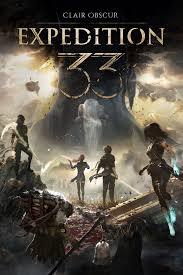 First, the story. Just… wow. In Expedition 33, the world of Lumiere is both dark and beautiful. People live in a strange reality where a godlike being called The Paintress appears once a year to mark a tower in the distance with a number that represents the age of people that will now disappear in an Avengers: Infinity War like snap. Each year, there is an expedition made up of brave souls willing to risk their lives to get close to The Paintress and work out the mysteries of their world in order to save those who follow. The story starts start and gets you invested in this seemingly suicidal mission early on with a great introduction to the characters and world with nothing held back. This game is all about no wasted moments and that is a nice change of pace for an RPG, especially with its relatively short (compared to other RPGs) 30 odd hours for the main story.
First, the story. Just… wow. In Expedition 33, the world of Lumiere is both dark and beautiful. People live in a strange reality where a godlike being called The Paintress appears once a year to mark a tower in the distance with a number that represents the age of people that will now disappear in an Avengers: Infinity War like snap. Each year, there is an expedition made up of brave souls willing to risk their lives to get close to The Paintress and work out the mysteries of their world in order to save those who follow. The story starts start and gets you invested in this seemingly suicidal mission early on with a great introduction to the characters and world with nothing held back. This game is all about no wasted moments and that is a nice change of pace for an RPG, especially with its relatively short (compared to other RPGs) 30 odd hours for the main story.
The story is dark. Really dark at times. Grimdark fans will be in their element with each beat of the story. The themes of mortality and grief are handled with such beauty that it was difficult to play at times and the French artistry and stunning soundtrack added to that to create something wholly unique. It was interesting to see how characters behave differently in a world where death is so prevalent and close. The strength in the decisions made by some of the main and supporting cast allow for moments of reflection and create a story that is timeless and certainly one that stands out. There are moments of levity, with gestrals in particular providing some comic relief along with some fun mini games and the dark humour and loving lines delivered by the incredible cast including Charlie Cox (Daredevil: Born Again) Andy Serkis (Lord of the Rings, Andor) Ben Starr (Final Fantasy XVI) and Jennifer English (Baldur’s Gate III).
Expedition 33 is also a game that just plays really well. The turn-based combat is a throwback to old RPGs with a modern twist and you can build characters in different ways as you grow through the game to target different opponents that get steadily more difficult throughout. The gameplay is easy to pick up but challenging to master and there are some extra horrible bosses to take on even once you have finished the main story. It allows you moments to breathe and just enjoy the absolute beauty of the world that Sandfall have created and to take in some of the heavy moments in the story. Games like God of War, Final Fantasy XVI, and The Last of Us 1 & 2 have all excelled at telling stories about grief and the effects it can have on people and Expedition 33 joins that heavyweight list of classics and perhaps even stands above them all in terms of its amazing story.
I could write all day about Expedition 33. This is a modern classic climbing high onto the shoulders of Japanese RPGs and wrapped in a stunning cloak of French artistry. Its original, dark story is one of the best I have ever had the fortune to play and for fans of grimdark, this is the game of the year. Sandfall have painted a masterpiece that deserves all the accolades that will be coming its way. Simply stunning.
Buy Clair Obscur: Expedition 33The post REVIEW: Clair Obscur: Expedition 33 appeared first on Grimdark Magazine.
July 25, 2025
REVIEW: Warrior Princess Assassin by Brigid Kemmerer
Upon reading the title of Brigid Kemmerer’s adult debut, you (like me) may be led to believe that the title refers to one singular person. I’m here to tell you that you’re wrong! Princess Jory of Astranza has often been kept in the dark when it comes to the ruling of her kingdom. When her brother, Prince Dane, offers Jory as a bargaining chip in a treaty with the neighbouring Kingdom of Incendar, she must obey and play the role that has been expected of her since her birth. King Maddox of Incendar is a warrior; feared amongst kingdoms as a ruthless man, known for his fire-led massacres on the battle field, and even the timely murder of his mother. When he is offered Princess Jory’s hand in marriage, he finds that it also comes with her father’s powerful ability to control weather; a necessity for his Kingdom, whose crops are dying and people are too. Asher is an assassin, but also Jory’s closest childhood friend. When his mother was executed for treason, he was exiled at the age of 16, and forced to fend for himself in a city heavily run by an economy of slavers. Escaping the slavers, he joins an Assassins Guild, and is forced to dole out murders for anonymous patrons. When he receives two job ledgers paying for the assassinations of both Princess Jory and King Maddox, Asher must take matters into his own hands and save the woman he loves, even if that means also saving her betrothed.
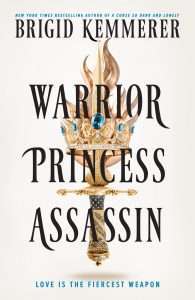 This novel was heaps of fun. I flew threw this book in three sittings, and was pleasantly surprised by how entertaining it was, despite the simple storyline. The characters certainly drove the story rather than the plot. It does follow a poly/‘why choose?’ romantic thread, which isn’t my cup of tea but I can imagine will certainly be many others’! The multiple points of views really allowed the readers into the heads of each character, as well as the internal struggles that drove each of their decisions.
This novel was heaps of fun. I flew threw this book in three sittings, and was pleasantly surprised by how entertaining it was, despite the simple storyline. The characters certainly drove the story rather than the plot. It does follow a poly/‘why choose?’ romantic thread, which isn’t my cup of tea but I can imagine will certainly be many others’! The multiple points of views really allowed the readers into the heads of each character, as well as the internal struggles that drove each of their decisions.
The grimdark aspect is rife; and we find this mainly in the handling of Asher’s character. His backstory lends itself to a lot of gruesome details, as he had been the subject of several torturous treatments, from slavery, to torture, to sexual assault. It is no wonder that his character is the morally grey of the bunch, and thus the main driving force of the story. I found that the focus generally shifted away from Jory, and the main connection being explored was Maddox and Asher’s, which felt ultimately quite refreshing.
Brimming with power, angst and the promise of hope, Warrior Princess Assassin is a foray into romantasy that sets itself apart from the rest of the genre purely due to the band of characters themselves. Whilst the story was simple, the entertainment was certainly not. The journey, whilst predictable, led us to a satisfying ending, leaving you wanting for more. Readers are in for a ride!
Read Warrior Princess Assassin by Brigid KemmererThe post REVIEW: Warrior Princess Assassin by Brigid Kemmerer appeared first on Grimdark Magazine.



